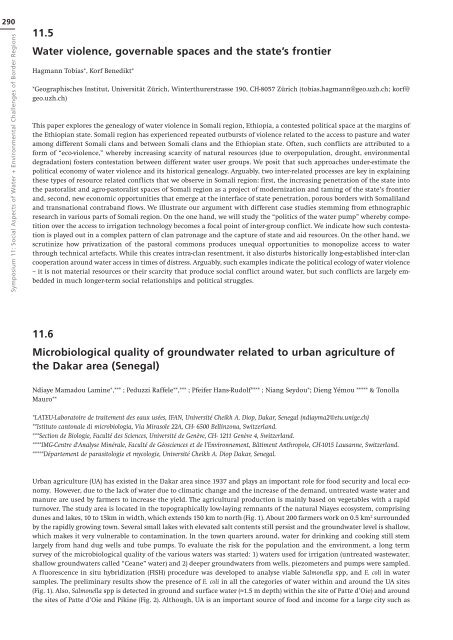Open Session - SWISS GEOSCIENCE MEETINGs
Open Session - SWISS GEOSCIENCE MEETINGs
Open Session - SWISS GEOSCIENCE MEETINGs
Create successful ePaper yourself
Turn your PDF publications into a flip-book with our unique Google optimized e-Paper software.
2 0<br />
Symposium 11: Social Aspects of Water + Environmental Challenges of Border Regions<br />
11.<br />
Water violence, governable spaces and the state’s frontier<br />
Hagmann Tobias*, Korf Benedikt*<br />
*Geographisches Institut, Universität Zürich, Winterthurerstrasse 190, CH-8057 Zürich (tobias.hagmann@geo.uzh.ch; korf@<br />
geo.uzh.ch)<br />
This paper explores the genealogy of water violence in Somali region, Ethiopia, a contested political space at the margins of<br />
the Ethiopian state. Somali region has experienced repeated outbursts of violence related to the access to pasture and water<br />
among different Somali clans and between Somali clans and the Ethiopian state. Often, such conflicts are attributed to a<br />
form of “eco-violence,” whereby increasing scarcity of natural resources (due to overpopulation, drought, environmental<br />
degradation) fosters contestation between different water user groups. We posit that such approaches under-estimate the<br />
political economy of water violence and its historical genealogy. Arguably, two inter-related processes are key in explaining<br />
these types of resource related conflicts that we observe in Somali region: first, the increasing penetration of the state into<br />
the pastoralist and agro-pastoralist spaces of Somali region as a project of modernization and taming of the state’s frontier<br />
and, second, new economic opportunities that emerge at the interface of state penetration, porous borders with Somaliland<br />
and transnational contraband flows. We illustrate our argument with different case studies stemming from ethnographic<br />
research in various parts of Somali region. On the one hand, we will study the “politics of the water pump” whereby competition<br />
over the access to irrigation technology becomes a focal point of inter-group conflict. We indicate how such contestation<br />
is played out in a complex pattern of clan patronage and the capture of state and aid resources. On the other hand, we<br />
scrutinize how privatization of the pastoral commons produces unequal opportunities to monopolize access to water<br />
through technical artefacts. While this creates intra-clan resentment, it also disturbs historically long-established inter-clan<br />
cooperation around water access in times of distress. Arguably, such examples indicate the political ecology of water violence<br />
– it is not material resources or their scarcity that produce social conflict around water, but such conflicts are largely embedded<br />
in much longer-term social relationships and political struggles.<br />
11.6<br />
Microbiological quality of groundwater related to urban agriculture of<br />
the Dakar area (Senegal)<br />
Ndiaye Mamadou Lamine*,*** ; Peduzzi Raffele**,*** ; Pfeifer Hans-Rudolf**** ; Niang Seydou*; Dieng Yémou ***** & Tonolla<br />
Mauro**<br />
*LATEU-Laboratoire de traitement des eaux usées, IFAN, Université Cheikh A. Diop, Dakar, Senegal (ndiayma2@etu.unige.ch)<br />
**Istituto cantonale di microbiologia, Via Mirasole 22A, CH- 6500 Bellinzona, Switzerland.<br />
***Section de Biologie, Faculté des Sciences, Université de Genève, CH- 1211 Genève 4, Switzerland.<br />
****IMG-Centre d'Analyse Minérale, Faculté de Géosciences et de l’Environnement, Bâtiment Anthropole, CH-1015 Lausanne, Switzerland.<br />
*****Département de parasitologie et mycologie, Université Cheikh A. Diop Dakar, Senegal.<br />
Urban agriculture (UA) has existed in the Dakar area since 1937 and plays an important role for food security and local economy.<br />
However, due to the lack of water due to climatic change and the increase of the demand, untreated waste water and<br />
manure are used by farmers to increase the yield. The agricultural production is mainly based on vegetables with a rapid<br />
turnover. The study area is located in the topographically low-laying remnants of the natural Niayes ecosystem, comprising<br />
dunes and lakes, 10 to 15km in width, which extends 150 km to north (Fig. 1). About 200 farmers work on 0.5 km 2 surrounded<br />
by the rapidly growing town. Several small lakes with elevated salt contents still persist and the groundwater level is shallow,<br />
which makes it very vulnerable to contamination. In the town quarters around, water for drinking and cooking still stem<br />
largely from hand dug wells and tube pumps. To evaluate the risk for the population and the environment, a long term<br />
survey of the microbiological quality of the various waters was started: 1) waters used for irrigation (untreated wastewater,<br />
shallow groundwaters called “Ceane” water) and 2) deeper groundwaters from wells, piezometers and pumps were sampled.<br />
A fluorescence in situ hybridization (FISH) procedure was developed to analyse viable Salmonella spp, and E. coli in water<br />
samples. The preliminary results show the presence of E. coli in all the categories of water within and around the UA sites<br />
(Fig. 1). Also, Salmonella spp is detected in ground and surface water (≈1.5 m depth) within the site of Patte d’Oie) and around<br />
the sites of Patte d’Oie and Pikine (Fig. 2). Although, UA is an important source of food and income for a large city such as









